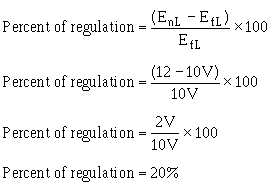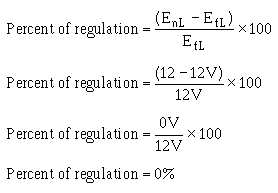4-36
This equation compares the change in output voltage at the two loading extremes to the voltage
produced at full loading. For example, assume that a power supply produces 12 volts when the load
current is zero. If the output voltage drops to 10 volts when full load current flows, then the percent of
regulation is:
Ideally, the output voltage should not change over the full range of operation. That is, a 12-volt
power supply should produce 12 volts at no load, at full load, and at all points in between. In this case, the
percent of regulation would be:
Thus, zero-percent load regulation is the ideal situation. It means that the output voltage is constant
under all load conditions. While you should strive for zero percent load regulation, in practical circuits
you must settle for something less ideal. Even so, by using a voltage regulator, you can hold the percent
of regulation to a very low value.
REGULATORS
You should know that the output of a power supply varies with changes in input voltage and circuit
load current requirements. Because many electronic equipments require operating voltages and currents
that must remain constant, some form of regulation is necessary. Circuits that maintain power supply
voltages or current outputs within specified limits, or tolerances are called REGULATORS. They are
designated as dc voltage or dc current regulators, depending on their specific application.
Voltage regulator circuits are additions to basic power supply circuits, which are made up of rectified
and filter sections (figure 4-30). The purpose of the voltage regulator is to provide an output voltage with





